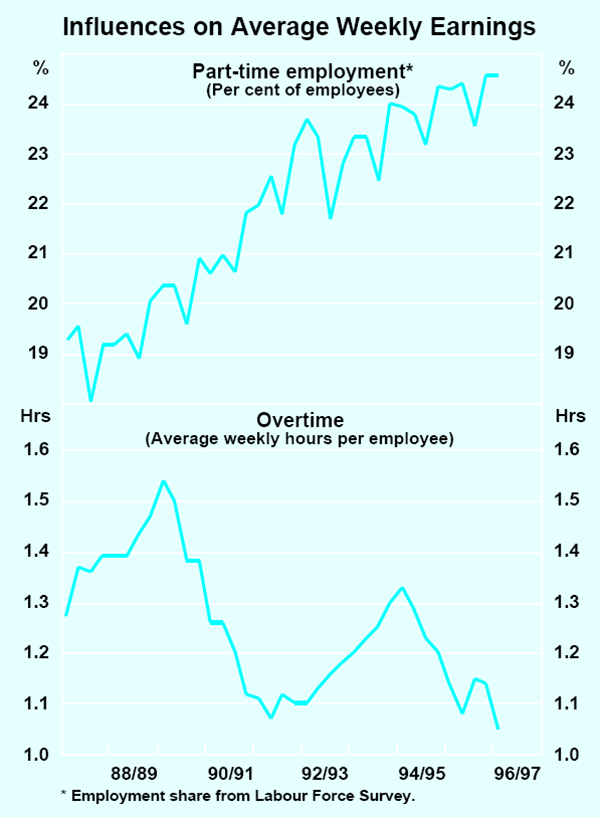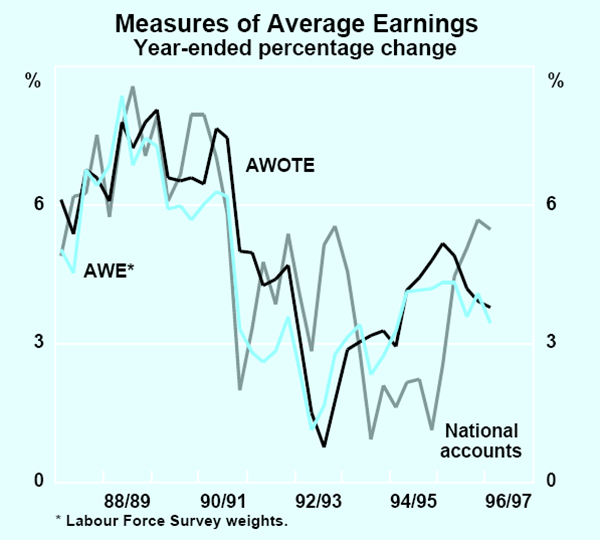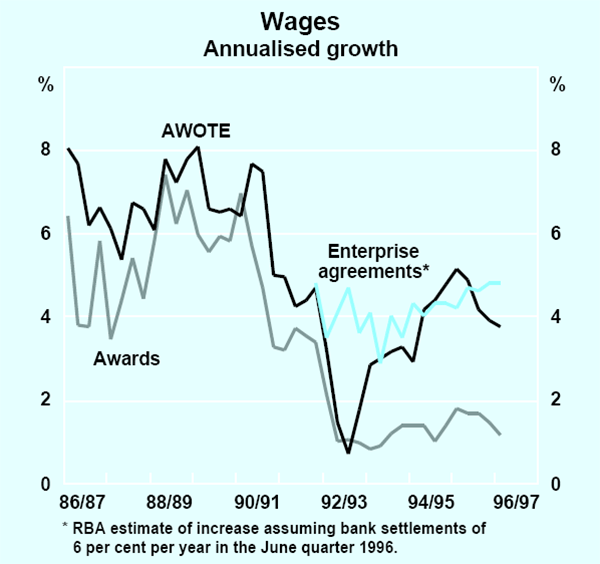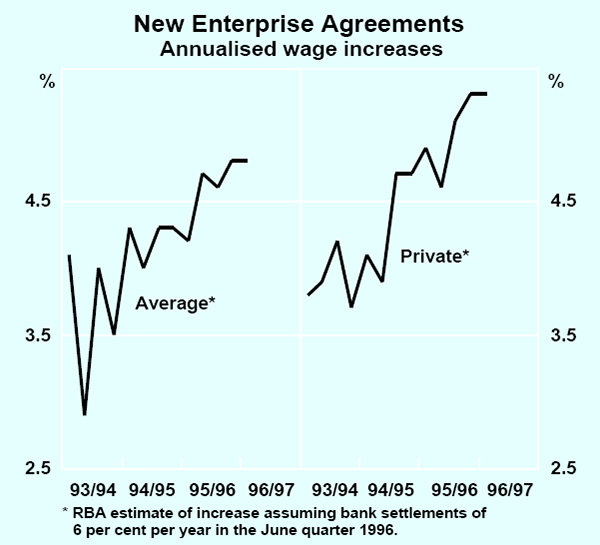Bulletin – December 1996 Measuring Wages
- Download 36KB
An accurate assessment of wage developments and an understanding of the relationships between inflation and wages are obviously important for monetary policy. Given the importance of labour costs in firms' total costs, wage increases are a major factor determining inflation. But the causation also runs the other way, as actual and expected inflation influence wage outcomes. Over recent years, the changing institutional arrangements for wage setting, the ongoing structural changes in the labour market, and the Reserve Bank's commitment to an inflation objective have complicated assessments of these relationships. These difficulties have been compounded by problems in obtaining a representative statistical measure of the ongoing movement in labour costs. Some of these issues are discussed below.
The Measures
Ideally, policy considerations would focus on an index of labour costs which was comprehensive in its coverage (including wages, salaries, superannuation, redundancy payments, and all other ‘on costs’). This index could be based on a constant representative sample of the labour force, or a variable basket which attempted to capture the effects of compositional changes in the work force. The Australian Bureau of Statistics (ABS) is working to produce an index of labour costs, but in the meantime, judgments need to be made on the basis of existing data series.
The two most comprehensive measures of overall labour costs are average total earnings, from the national accounts, and average weekly earnings (AWE), based on an ABS survey of employers. The first measures wages, salaries and supplements per non-farm wage and salary earner, and includes irregular bonuses, workers' compensation, superannuation and redundancy payments. The AWE measure has a similarly comprehensive coverage of the labour force, but does not include costs such as superannuation and redundancy payments.
Both these surveys have the advantage of being quite broad in coverage, but as measures of the increase in average wage rates they are distorted by changes in the composition of the workforce. For example, changes in the shares of part-time workers and those working over time will cause changes in average earnings even if wage rates are unchanged. Typically, part-time workers have lower earnings than full-time workers, so inclusion of their earnings lowers average wages per person. Reflecting structural changes in the economy, and changing preferences for part-time work, there has been a trend increase in part-time employment as a share of total employment (see Graph 1); this has reduced both the level and the growth of average earnings per person. In addition, the share of wage earners working overtime hours varies over the course of the business cycle, so that average earnings per person are higher during peaks of the business cycle and lower during periods of weak activity, even if wage rates remain unchanged.

Some adjustments can be made to reduce these distortions (for example, calculating these measures of earnings in terms of hours worked reduces the effect of changes in the share of full-time and part-time wage earners), but the shifting diversity of the labour force (and ‘lumpiness’ of some of the on-costs) can still distort the series.
Average weekly ordinary-time earnings (AWOTE) comes closer to the concept of a constant sample, as it records the wage increases of adults working full time. By focussing solely on ordinary-time hours it is not affected by cyclical variations in overtime or by the increasing share of part-time workers. While it does not cover all wage earners, it accounts for around three-quarters of the overall wage bill. It has, however, been affected by the redefinition of ordinary-time hours in many enterprise agreements. Despite its imperfections, the Bank uses this as the best single measure of past general wage developments, although the other series are monitored closely as well. Growth in AWOTE peaked at 5.1 per cent in the year to August 1995 and was 3.8 in the year to August 1996 (see Graph 2).

An alternative approach to examining these aggregate measures is to consider developments in different parts, or ‘streams’, of the labour market. As well as getting closer to understanding the forces driving wages, the hope is that this might provide more forward-looking insights on wage developments. Three wage streams can be identified. Roughly speaking, around one-third of workers are covered principally by awards; one-third are covered by formal enterprise agreements; and the remainder (the informal group) have a variety of arrangements, ranging from informal agreements to individual contracts.
Award wages have traditionally been the centrepoint of the centralised wage setting arrangements in Australia. These represent a legally enforceable determination by industrial tribunals. Until about 1993, awards provided a good measure of the pace of wage rises across the economy, because of their wide coverage. However, since 1993, award rates have grown significantly more slowly than AWOTE, with the increase mainly reflecting the ‘safety-net’ adjustments for wage earners who have not received wage increases under enterprise bargains (see Graph 3).

Enterprise agreements are negotiated between management and worker representatives, often at the level of the enterprise and, increasingly, at the level of the work place. Because these are disparate agreements, with varying duration, starting dates and conditions, it is more difficult to monitor and assess these accurately. The Department of Industrial Relations (DIR), however, compiles a series which endeavours to standardise wage increases through formal enterprise agreements in the federal jurisdiction (other organisations also compile statistics of varying coverage) (see Graph 4). Analysis of current settlements based on press reports is made difficult by the practice of reporting and discussing wage rises in terms of the gross increase over the period of the agreement (normally more than a year), rather than wage rises per annum.

Informal sector arrangements are negotiated between parties at the level of the workplace, and often include individual contracts. The sector includes some low-skilled workers, but is largely made up of managers and professionals. It is difficult to monitor the wages of these groups of workers since agreements are not registered and official data are not collected. Nevertheless, private-sector surveys of professional remuneration provide some guide to wage developments in this area.
Assessment
All three streams of bargaining are affected by broad macroeconomic forces such as inflation, the pace of economic growth and the unemployment rate, although the degree of sensitivity to these forces clearly varies across the different streams. An extra degree of cyclical variation in labour costs is introduced by the tendency for larger over-award payments and faster rates of promotion to occur in tight labour markets. These factors mean that AWOTE has tended to have greater cyclical variation than either awards or enterprise agreements.
The slowing of growth in AWOTE over the past year is in large part a result of the softer labour market. The slowing has improved the immediate outlook for inflation. A clear reduction in inflation should help reinforce in the minds of those at the bargaining table that low inflation is sustainable and, in turn, this should help lower expected nominal wage increases.
From the perspective of monetary policy, maintaining inflation and wage expectations consistent with the Bank's inflation objective is critically important. Ideally, this would require a measure of the underlying pace of wage growth, excluding the short-term influence of the current cyclical conjuncture. On currently available measures of aggregate labour costs such assessments are difficult, but outcomes from enterprise bargaining provide one source of evidence since they provide information about wage expectations. The interpretation of enterprise agreements is, however, complicated by a number of factors including the transition from a centralised to a more decentralised labour market. In this transition period, it seems quite likely that the group in the economy with the strongest bargaining power (which might well be those with enterprise agreements) would be achieving higher wage increases than the community average.
Notwithstanding this complication, continuing high outcomes from enterprise bargaining suggest that some workers and management remain to be convinced that the Bank will achieve its inflation objective. In 1995/96, the Bank expressed concern that despite a softer labour market, wage increases in enterprise agreements continued to accelerate. The concern has been that these high outcomes might influence more general perceptions of expected wage increases, so that when employment growth picked up, aggregate wage growth would accelerate. Such an outcome would have undesirable effects on employment and inflation.
Looking ahead, the same issues remain relevant: how will aggregate wage growth respond to the cycle in employment growth, and what effect will lower inflation outcomes have on wage expectations and outcomes from bargaining? Adjusting the DIR figures for wage increases in enterprise agreements to take account of problems in recording duration and timing of recent bank wage increases, the pace of wage growth through enterprise bargaining seems to have plateaued. Given this, whilever those workers on the awards stream are receiving the sorts of modest increases of recent years, the aggregate outcome seems likely to remain consistent with the 2–3 per cent inflation objective. The differences in wage outcomes from enterprise bargains and awards may be a normal outcome during a period of transition to a more market-oriented labour market. To the extent that the resultant increase in wage flexibility reflects appropriate rewards for skill, it should be helpful for employment growth.
Whether or not this greater dispersion of wages will be sustained over the medium term depends upon a range of economic, social and institutional factors. The ‘Living Wage’ case currently under consideration by the Industrial Relations Commission is one relevant factor.[1] While a ‘safety-net’ increase of the type given over recent years (and proposed by the Government) would be consistent with the current rate of aggregate wage increase, the full Living Wage claim would imply a marked acceleration of wages growth. Estimates of the impact of the claim are necessarily imprecise, as the number of workers affected directly is not known exactly, nor is the rate of increase in award wages which would take place in the absence of the claim. In addition to the direct effects there will be second and third-round effects for other workers. The Bank has prepared some estimates based on the view that workers who receive only award wages account for around one-fifth of the nation's wage bill and that Stage 1 of the claim would increase these workers' wages by 8¾ per cent. The estimates also allow for some effect on the wages of workers who currently obtain small over-award payments. Based on these factors, the direct effect of the Living Wage claim would be to increase the economy-wide wages bill by close to 2 percentage points. At present, the group of employees subject to the claim is contributing around 0.4 of a percentage point to the annual increase in AWOTE. As a result, the Bank estimates that the claim would add a further 1.6 percentage points to current annual growth in AWOTE. This direct effect, alone, would take aggregate wage growth to well over 5 per cent. Furthermore, flow-on effects to the wages obtained in other streams of bargaining would mean that the full effect of the Living Wage claim on aggregate wage growth would be considerably higher than the above estimates.
To achieve the Bank's inflation objective, and at the same time reduce the unemployment rate, aggregate wage growth must reflect economy-wide productivity growth and low inflation expectations. The deregulation of the labour market is making it more difficult to assess prospective trends in underlying wages growth and complicating analysis of the relationships between inflation and wages. No single measure of wages can be relied upon exclusively.
Footnote
Stage 1 of the claim seeks an increase in award wages of 8.75 per cent and, in addition, seeks a $20 per week safety-net payment which the ACTU proposes will be offset against the higher awards, but not over-award payments. [1]